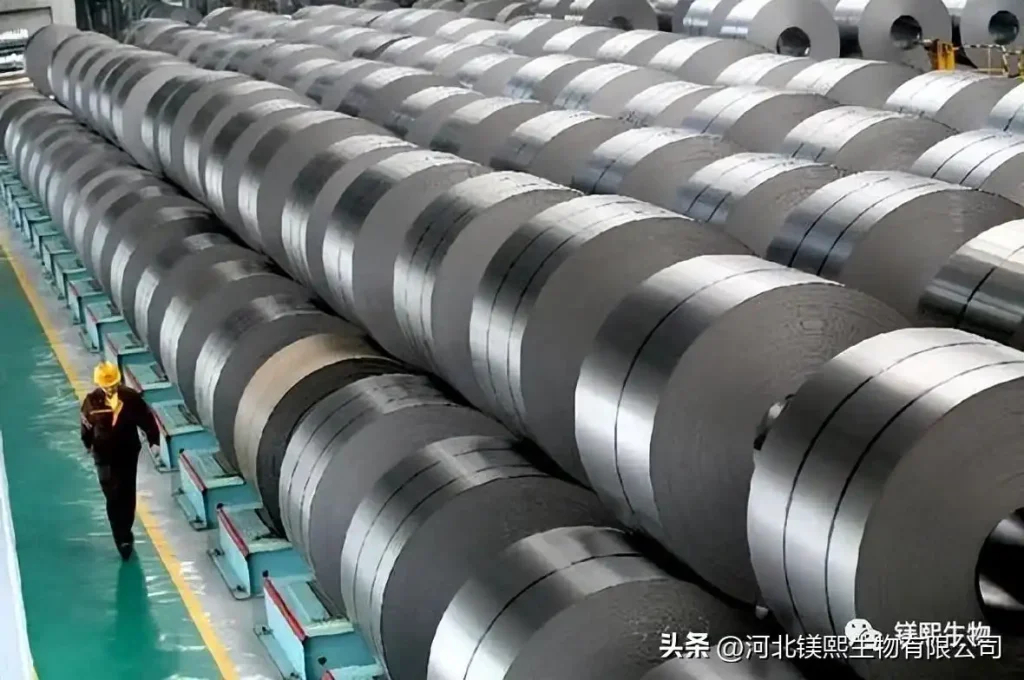Tibet Mag said, the production of silicon steel grade magnesium oxide is mainly based on seawater brine and minerals, etc. as raw materials. When producing with liquid raw material, we first use alkaline solution as precipitant to precipitate magnesium, and then further prepare magnesium oxide. Our country mainly adopts alkaline magnesium carbonate as intermediate brine – ammonium carbonate method and magnesium hydroxide as intermediate brine – ammonia method, Japan, Israel, etc. mostly use calcium hydroxide as precipitant. The solid ore method mainly adopts magnesite, dolomite carbonization method, after digestion, carbonization and other processes, with alkaline magnesium carbonate as intermediates, and then calcined to produce.
A, brine – ammonium carbonate method to prepare silicon steel grade magnesium oxide
Ammonium carbonate, ammonium bicarbonate and other precipitating agents and brine in the reactor heating reaction to produce alkaline magnesium carbonate intermediates, after filtration, washing, drying, calcination, heat treatment and other processes, to obtain silicon steel grade magnesium oxide. The product purity is more than 98%, the average particle size is 3.182μm, the particle size less than 5um reaches 71.27%, the hydration rate is less than 4%, which meets the technical index requirement of silicon steel grade magnesium oxide. With brine, ammonium bicarbonate and ammonia carbonate as raw material, the precipitation reaction is carried out in the reactor, and the highly active magnesium oxide is made by calcination first, and then the magnesium hydroxide is obtained by hydration under certain conditions, and then dried and calcined, that is, the silicon steel grade magnesium oxide is obtained, and the magnesium oxide content reaches more than 98%, and the hydration rate and coating property reach the requirements of silicon steel sheet production. In addition, the viscosity of the product is high, which solves the problem that the traditional silicon steel grade magnesium oxide viscosity is low to meet the demand of some silicon steel sheet factories for magnesium oxide viscosity above 80mPa-s. The product has the characteristics of high chemical purity (>99.1%), small average particle size and high viscosity, good coating and adhesion, etc.
Ammonium carbonate method is used to prepare silicon steel grade magnesium oxide, the production process is relatively mature, the product quality is stable and reliable, and has achieved industrial production. The disadvantage is that when preparing alkaline magnesium carbonate, it is difficult to recover the by-product ammonium chloride due to the low concentration of the reaction system, which is easy to cause environmental pollution. Although the ammonium chloride in the mother liquor can be recovered by evaporation, but the concentration of ammonium chloride is too low, the energy consumption is too high, and the process is complicated and not easy to control. And production of each ton of products, ammonium bicarbonate consumption of up to 6 ~ 7t, electricity consumption of 1000kWh, coal consumption of 8 ~ 9t, the cost is high.
Second, brine – ammonia preparation of silicon steel grade magnesium oxide
Using brine and ammonia continuous reaction process, by adjusting the reaction time, control the magnesium hydroxide crystalline size in 0.2 ~ 2.0μm, and 800 ~ 900 ℃, 30 ~ 60min conditions, dynamic calcination of magnesium hydroxide to get silicon steel grade magnesium oxide. The magnesium hydroxide intermediate was obtained by controlling the pH value of the reaction system to 11, using brine with magnesium chloride concentration of 4.3 mol/L and ammonia at pH 13.5 as raw material, and calcined at 950℃ in a chamber resistance furnace and cooled under airtight conditions. Add ethanol, crushed by ball mill, and finally sieved to obtain silicon steel grade magnesium oxide. The product has irregular spherical shape under electron microscope, and the appearance is flaky, and the particle size is relatively uniform. The average particle size of magnesium oxide after grinding is 5μm, with normal distribution, the purity of the product is >98%, and the hydration rate is 3.5%, which meets the requirement of silicon steel grade magnesium oxide.
The advantages of brine-ammonia method are low requirement for equipment, wide source of raw material, and small scale. The disadvantage is that the intermediate magnesium hydroxide obtained from ammonia as raw material has small particle size and is difficult to settle and filter. When the concentration of ammonia is high, the viscosity of magnesium hydroxide is large, it is difficult to separate; when the concentration of ammonia is low, the utilization rate of magnesium is low. At the same time, the volatilization of ammonia leads to poor operating environment and difficult to deal with by-product mother liquor.
Three, magnesium ore carbonization method to prepare silicon steel grade magnesium oxide
Take dolomite as raw material, calcine in high temperature resistance furnace to generate dolomite ash, after digestion, purification, carbonization, pyrolysis, get alkali magnesium carbonate intermediate, then by aging, washing, drying, calcination, get magnesium oxide, crushing, sieving, get silicon steel grade magnesium oxide, product purity 98.93%, hydration rate of 3.2%, particle size (5μm) > 82%, the indicators are better than the enterprise standard. Magnesite was used as raw material, calcined in high temperature resistance furnace to produce lightly burned powder, then digested to make magnesium hydroxide emulsion, after carbonization to obtain alkali magnesium carbonate intermediate, high temperature calcination to prepare the silicon steel grade magnesium oxide to meet the enterprise standard. Research shows that the suitable concentration of magnesium oxide in the light burned powder emulsion is 15~20g/L, and the pH value of carbonization end point is 7.0~7.1. The temperature of heavy magnesium hydrolysis is controlled in 80~90℃, and the average particle size of the product can be controlled in 5~6um; the calcination temperature is controlled in 950℃, and the cooling under the condition of air isolation, and the activity and hydration rate required for silicon steel grade magnesium oxide can be obtained.

The preparation of silicon steel grade magnesium oxide by magnesite carbonization method has long reaction cycle, complex process and high production cost, and the product purity is low due to the influence of impurities in raw materials.
